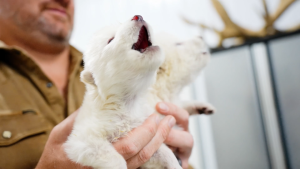For centuries, the dire wolf (Canis dirus) has captivated our imaginations, both for its size and its role as one of the top predators of the Pleistocene epoch. Extinct for over 10,000 years, this massive carnivore still captures the minds of those fascinated by the mysteries of the past. But what if the dire wolf didn’t have to remain a relic of ancient history? Could it come back to life?
In this article, we will explore the possibility of resurrecting the dire wolf using modern scientific advancements, along with a deep dive into its history, extinction, and the potential benefits of bringing this mighty predator back to the wild.

The Extinct Dire Wolf A Glimpse Into Prehistoric History
What Was the Dire Wolf?
The dire wolf was a formidable predator that roamed North America during the Pleistocene era. About 25% larger than today’s gray wolf, it was an apex predator that hunted large herbivores such as bison, mammoths, and even horses. With a powerful bite force and muscular build, the dire wolf was well-equipped to survive the harsh climates of the Ice Age.
Unlike modern wolves that rely heavily on speed, the dire wolf likely used its size and strength to overpower prey, often hunting in packs to bring down much larger animals. Its large teeth, strong jaws, and highly social behavior made it an effective and dangerous predator in its ecosystem.
The Extinction of the Dire Wolf
The dire wolf went extinct around 10,000 years ago, likely due to a combination of climate change and human hunting. As the Ice Age ended and the climate warmed, the large herbivores that the dire wolf relied on for food began to disappear. Additionally, the arrival of early humans on the continent may have contributed to the decline of these giant predators.
Despite its extinction, the dire wolf’s legacy continues to thrive in modern culture, largely due to its prominent role in books, television, and movies, such as Game of Thrones, where it serves as a symbol of strength and loyalty.
The Science Behind Bringing the Dire Wolf Back to Life
De-Extinction: A New Frontier
The idea of resurrecting extinct species, known as de-extinction, has moved from the realm of science fiction to scientific possibility. With advancements in genetics, cloning, and biotechnology, some species once thought irretrievably lost could soon be brought back to life. But is the dire wolf one of those species?
Researchers are now exploring the possibility of resurrecting the dire wolf through a process called cloning. Using DNA extracted from preserved dire wolf remains, such as those found in the La Brea Tar Pits in California, scientists hope to recreate the animal by inserting its genetic material into a closely related species modern wolves or even coyotes.
However, this process is not without significant challenges. The DNA of extinct animals, especially those as old as the dire wolf, is often fragmented and incomplete, which makes the cloning process more difficult. Nonetheless, scientists have successfully cloned animals like sheep and cattle in the past, and with continuous advances in genetic engineering, the idea of reviving the dire wolf may no longer be impossible.
The Role of CRISPR Technology
CRISPR technology, a powerful gene-editing tool, has made headlines for its potential to alter DNA and even bring extinct species back to life. Researchers are investigating the possibility of using CRISPR to edit the genes of modern wolves, inserting specific traits that would make them more like their ancient relatives.
In fact, some geneticists believe that by editing the DNA of wolves and adding specific genes related to the dire wolf, they could effectively recreate the dire wolf’s appearance, size, and certain behavioral traits. Though this process is still in its infancy, it holds tremendous promise for the future of de-extinction.
Could the Dire Wolf Thrive in the Modern World?
While the science of bringing the dire wolf back is exciting, there’s the pressing question of whether it could truly thrive in today’s world. The ecosystems that the dire wolf once ruled are vastly different now. The large herbivores it once hunted are largely gone, and the climate has warmed significantly. Would the dire wolf be able to find enough food? How would it interact with modern wolves, which have already claimed many of the territories that were once home to the dire wolf?
Ecologists are divided on whether the reintroduction of the dire wolf would be a wise idea. Some argue that it could restore balance to ecosystems that have changed significantly since its extinction. Others worry that bringing such a large predator back could disrupt existing wildlife populations and create new environmental challenges.
The Dire Wolf’s Role in Popular Culture
From Ancient Predator to Cultural Icon
Even though the dire wolf has been extinct for thousands of years, its legacy lives on in popular culture. The most famous portrayal of the dire wolf is undoubtedly in Game of Thrones, where the Stark children are each gifted a dire wolf as a companion. The symbolic role of the dire wolf as a loyal and powerful animal deeply connects with the themes of family, strength, and survival in the series.
But Game of Thrones isn’t the only place where the dire wolf makes an appearance. The creature has been featured in numerous video games, books, and even movies, often symbolizing the wild, untamed forces of nature. This cultural presence has ensured that the dire wolf, despite its extinction, continues to resonate with audiences worldwide.
The Dire Wolf in Science Fiction
In addition to its role in fantasy and historical fiction, the dire wolf has also made its mark in science fiction. The idea of resurrecting extinct species is a common theme in sci-fi literature and films. One of the most famous examples is Jurassic Park, where scientists use advanced technology to bring back dinosaurs. The potential for the dire wolf to be brought back to life in a similar fashion is a concept that continues to captivate writers and filmmakers alike.
FAQs About the Dire Wolf and Its Potential Resurrection
1. Could the dire wolf really come back to life?
Yes, there is potential for the dire wolf to be resurrected through advancements in genetics and cloning technologies. Scientists are currently exploring the use of preserved DNA and CRISPR technology to bring this iconic predator back.
2. Why did the dire wolf go extinct?
The exact cause of the dire wolf’s extinction is still debated. However, it is believed that climate change, the disappearance of large prey species, and possibly human hunting contributed to their demise around 10,000 years ago.
3. How does CRISPR work in bringing back extinct species?
CRISPR is a gene-editing technology that allows scientists to alter the DNA of living organisms. By adding genes from the extinct species into the DNA of a closely related species, scientists can recreate the physical and genetic traits of the extinct animal.
4. Would the dire wolf be able to survive in today’s environment?
There are significant challenges to reintroducing the dire wolf into today’s ecosystem. The loss of large prey species and changes in the environment make it uncertain whether the dire wolf could thrive in modern habitats.
5. What other extinct animals could be brought back using cloning?
In addition to the dire wolf, scientists are exploring the possibility of bringing back other extinct species such as the woolly mammoth, the passenger pigeon, and the thylacine (Tasmanian tiger).
Final Thoughts: The Dire Wolf’s Place in History and Our Future
The dire wolf remains an icon of prehistoric life, a powerful predator that once roamed the vast landscapes of North America. While the idea of resurrecting this magnificent creature may seem like something out of science fiction, advances in genetics and cloning offer a glimmer of hope for those who dream of seeing the dire wolf return. Whether or not this powerful creature will ever walk the Earth again remains uncertain, but the desire to bring it back reflects humanity’s deep fascination with the past and the possibilities of the future.
Want to Learn More About the Dire Wolf?
Explore more articles and studies about the dire wolf, de-extinction, and the science behind resurrecting extinct species. Stay informed and continue to uncover the mysteries of the ancient world!










